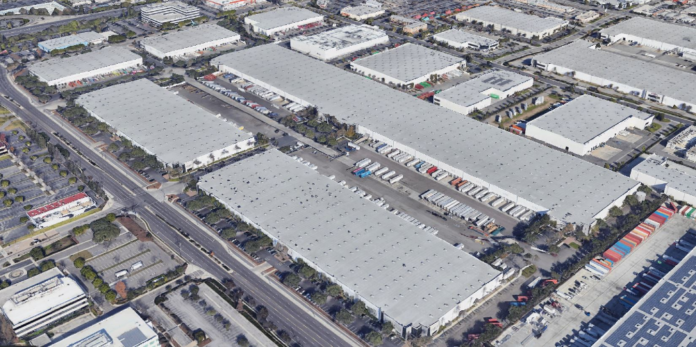Come June, managers overseeing local warehouses larger than 150,000 square feet will have start keeping track of trucks arriving at their cargo docks in addition to handling their merchandise.
The data collection is part of the Warehouse Indirect Source Rule (ISR) implemented by the South Coast Air Quality Management District on May 7, 2021, which aims to reduce nitrogen oxide and diesel particulate matter emissions in neighborhoods near industrial properties.
“About half of the air pollutants that contribute to smog come from the goods movement industry, with the largest source being heavy-duty trucks heading to warehouses across Southern California,” South Coast AQMD Executive Officer Wayne Nastri said in a statement. “Adoption of the warehouse rule is a major step towards reducing air pollution and protecting the millions of people directly impacted by this type of pollution.”
Warehouse operators are asked to log truck arrivals and departures, as well as the type of truck that delivered the goods — Class 8 trucks, such as big rigs, are weighted 2.5 times more heavily for emission impact than smaller Class 2b-7 trucks. The data is then used to calculate Warehouse Actions and Investments to Reduce Emissions (WAIRE) Points Compliance Obligation that can be offset by paying a mitigation fee.
The warehouse operators can also earn WAIRE points by acquiring and using natural gas, near-zero emissions or zero-emissions trucks and cargo-handling equipment and installing solar panels or zero-emission charging and fueling infrastructure, according to the South Coast AQMD.
Reporting timeline
The ISR will be implemented gradually. The first cohort that had to comply included warehouses with more than 250,000 square feet of space within a single building. Those operators started a 12-month data collection period on July 1, 2021, and their annual WAIRE report for 2022 is due on Jan. 31, 2023. The report will show their compliance obligation calculations and how many WAIRE points they’ve collected to offset it.
The ISR allots three years to meet the requirements, so for the first reporting period, operators will have to show they’ve collected only a third of the points required for full compliance.

While the rule is already in effect, many warehouses still are not aware of it, according to JoAnne Golden, vice president at Gladstein, Neandross & Associates, a Santa Monica-based clean energy and advanced transportation consulting firm.
“There have been pretty significant communication efforts to try to inform them (but) just like anything, many people wait until something’s due before they pay attention to it,” Golden said. “My guess is when January rolls around next year and the reports are due, to be able to tally up that that final amount, many warehouse operators who are in that 250,000 square feet and above (category) will be a little surprised at what that number ends up looking like.”
Property owners meanwhile were only required to submit details about the size of their warehouse and information on their tenant and leases by Sept. 1, 2021.
The second wave of warehouses that need to jump through similar reporting and compliance hoops includes structures with more than 150,000 square feet of space.
Their 12-month data collection period starts on June 1, and their first annual WAIRE report will be due on Jan. 31, 2024.
The third and last group that needs to comply comprises warehouses that have more than 100,000 square feet of space. Their operators will follow a similar reporting schedule as the first two groups, with the data collection requirement starting on June 1, 2023.
According to South Coast AQMD’s estimates, the annual cost to comply with the ISR will range from $0 to $0.83 per square foot of warehouse space, depending on the truck traffic at each warehouse and mitigation measures operators choose to implement.
Noncompliance, however, can be costly as well. “We have seen the unmitigated impact from this rule range from a few hundred dollars, which is basically the cost of filing the report in many instances, to tens of millions of dollars annually,” Golden said.
Operator challenges
Golden said the ISR is interesting in the respect that the warehouse operators are responsible for mitigating things that are often not entirely in their control. For example, operators can’t choose what type of vehicle is sent to their facility to deliver or pick up the goods, such as whether it is a diesel-powered big rig or a zero-
emission delivery van. And if they lease the warehouse space, they usually need the property owner’s approval to make facility upgrades and offset their WAIRE points compliance obligation.
“They’re not the ones who have the ability to put solar on the roof … to put chargers on their site because they don’t own that property,” she said. “It can be definitely frustrating to some of these warehouse operators to figure out how they can comply.”
Questions remaining to be answered also include whether the warehouse owner or shipping companies sending trucks to the warehouses have a responsibility to support warehouse operators’ compliance efforts, she added.
Another challenge is with the multitenant facilities that are frequented by numerous transportation companies, where operators will have to find ways to separate and count truck trips destined to their space only. Some are relying on entry gate records, if a warehousing facility has one, while others use security footage to account for the truck trips, Golden said.
Earning compliance points by purchasing zero-emission vehicles, such as an electric yard truck, might be an easier path for some operators, she added.
“If they have their own fleet, maybe they could access incentive funding to help support the acquisition of the new cleaner vehicles,” Golden said, adding that the need for investment in clean vehicle technology is somewhat inevitable.
“I think (it’s) very important to understand is that this is not the only rule that is taking place right now that is going to require warehouse operators, or let’s just say vehicle operators generally, to get into newer, cleaner vehicle technology. This one just happened to take place a little bit before the other ones.”
But according to the California Trucking Association, the rule is one too many and the South Coast AQMD “has no lawful authority over tailpipes,” it stated in a lawsuit filed in the U.S. District Court for the Central District of California last year.
The Southern California chapter of the NAIOP, the Commercial Real Estate Development Association, is also opposing the ISR, and it challenged South Coast AQMD’s ability to regulate mobile sources of pollution and said that’s the California Air Resources Board’s jurisdiction. It issued a statement arguing that ISR implementation will result in “higher retail prices of consumer products and goods throughout Southern California. Proponents claim that it will improve air quality but have not presented data or facts to support this goal … Most warehouses will end up paying the fee (tax) because it will not be feasible or possible to comply with the regulation mandates. If this is the case, then the ISR regulation did nothing to improve air quality and only increased costs to business/consumers.”
Whichever side prevails, a lot is at stake. Los Angeles County is home to some 12,300 warehouses, providing more than 490 million square feet of space, according to Reonomy, a New York City-based analytics company specializing in commercial real estate. That compares to 2,111 warehouses in Orange County; 3,020 in San Bernardino County; and 196 in Ventura County.

